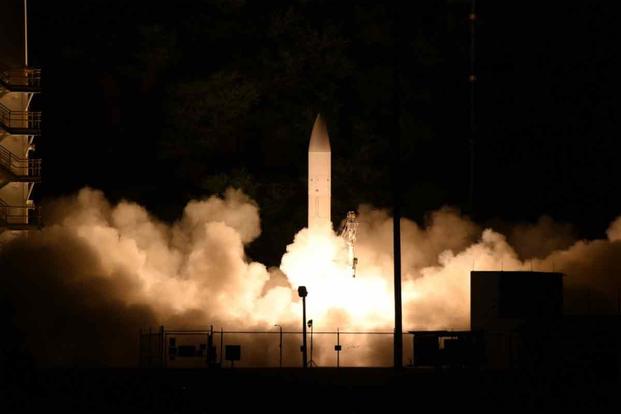The U.S. Navy and Army, in tandem with the Missile Defense Agency, conducted a test of a hypersonic weapon Thursday in the Pentagon's effort to make the technology an eventual staple in the military's inventory.
The Defense Department announced Friday it had conducted a successful flight test of a hypersonic glide body from the Pacific Missile Range Facility in Kauai, Hawaii.
"The U.S. Navy and U.S. Army jointly executed the launch of a common hypersonic glide body (C-HGB), which flew at hypersonic speed to a designated impact point," DoD officials said in a news release. "Concurrently, the Missile Defense Agency (MDA) monitored and gathered tracking data from the flight experiment that will inform its ongoing development of systems designed to defend against adversary hypersonic weapons."
Hypersonic weapons are expected to move at five times the speed of sound or more; the C-HGB was propelled by a modified Polaris A3 booster, according to USNI News.
Related: Pentagon Aims to Win Global Race for New Hypersonic Technologies
In a memo sent last month to Navy personnel, Acting Navy Secretary Thomas Modly said a crucial flight test for the glide body was scheduled for later this year.
Modly called the development of hypersonic technologies the "Sputnik" moment of the 21st century, comparing the early 1960s-era Space Race to a new global competition that could set the U.S. apart from its adversaries into the future.
"In fact, the possible applications of hypersonic technologies have already changed the nature of the battlespace, much as nuclear technology did in the past century. That is why, when it comes to hypersonic weapons, our command today must be 'All Ahead Full,'" Modly said in the memo.
Like nuclear weapons, officials have said hypersonic weapons can act as deterrents, as well as game changers, in responding to conflict from hundreds of miles away. Modly's memo outlined a robust schedule for the Navy, a lead service under the Pentagon's conventional prompt global strike program, which enables the U.S. military to strike targets anywhere globally within an hour.
In Friday's release, officials said the military is planning future experiments to expedite the fielding of "hypersonic warfighting capabilities in the early- to mid-2020s."
''This test builds on the success we had with Flight Experiment 1 in October 2017, in which our C-HGB achieved sustained hypersonic glide at our target distances,'' said Vice Adm. Johnny R. Wolfe, director of the Navy's Strategic Systems Programs.
The office is the lead designer for the C-HGB, with the Army leading production, according to the release.
''In this test, we put additional stresses on the system and it was able to handle them all, due to the phenomenal expertise of our top-notch team of individuals from across government, industry and academia. Today, we validated our design and are now ready to move to the next phase towards fielding a hypersonic strike capability," Wolfe said.
When fielded, it "will comprise the weapon's conventional warhead, guidance system, cabling and thermal protection shield," officials said. The two services are each tailoring individual launchers for future land or sea use, the DoD said.
The Pentagon has made hypersonic technologies a priority, nearly doubling its long-term investment -- almost $5 billion more in FY2020 in hypersonics development alone in the next five years, Defense Secretary Mark Esper said earlier this year.
The investments come as rivals Russia and China have made hypersonic technologies national programs of record and made recent advances. For example, Russia recently claimed to have unveiled its Avangard hypersonic glide vehicle, with potential to move more than 20 times the speed of sound.
"And our 2021 budget will be even stronger," Esper said Jan. 24 during a Center for Strategic and International Studies.
-- Oriana Pawlyk can be reached at oriana.pawlyk@military.com. Follow her on Twitter at @Oriana0214.
Read more: Watchdog: Pentagon Needs to Answer Questions on New F-35 Logistics System













